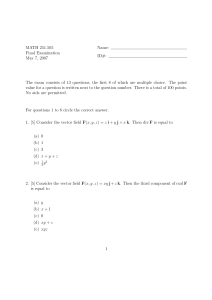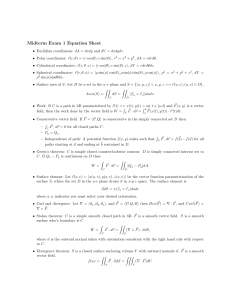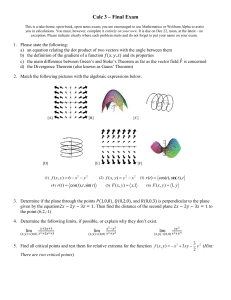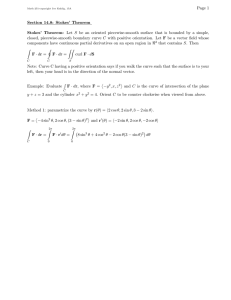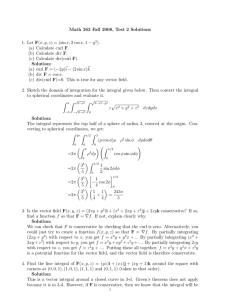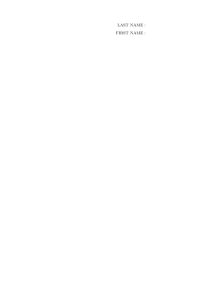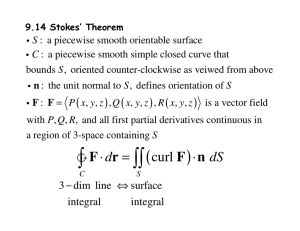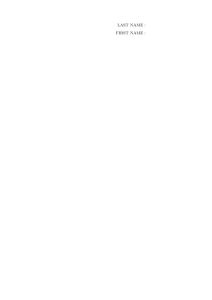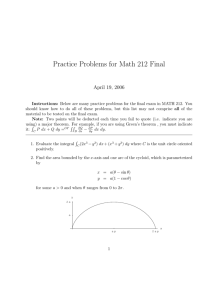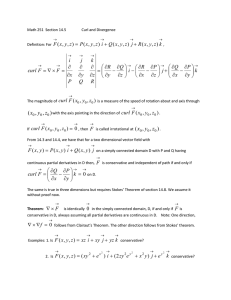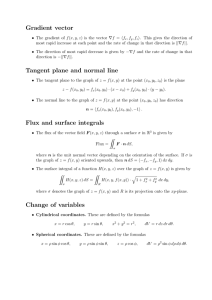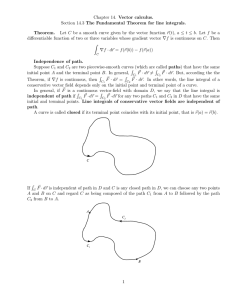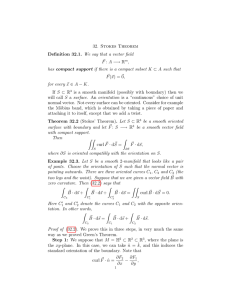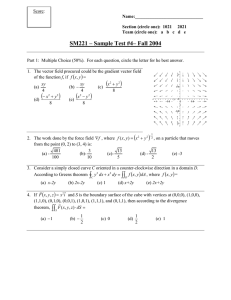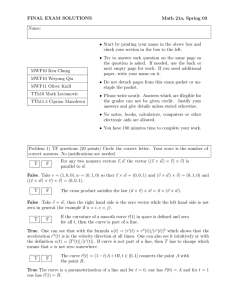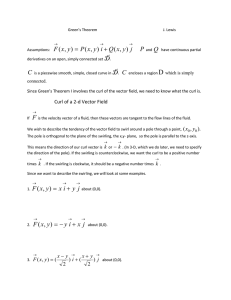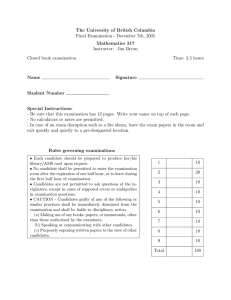MATH 251.504 Name: Final Examination ID#:
advertisement
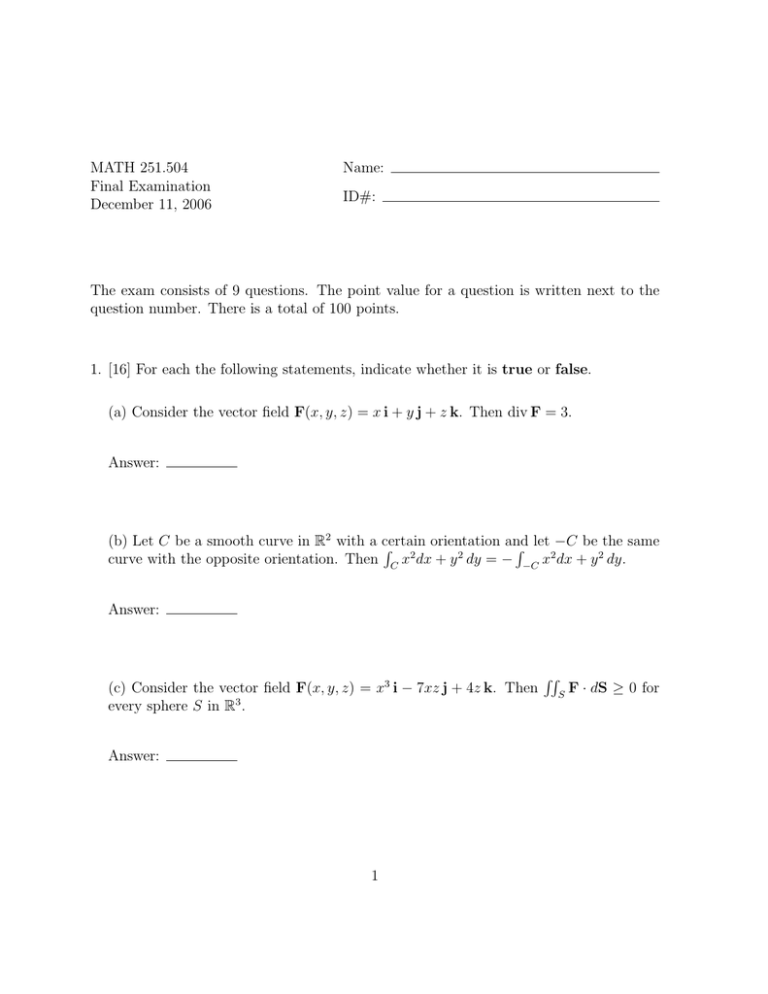
MATH 251.504
Final Examination
December 11, 2006
Name:
ID#:
The exam consists of 9 questions. The point value for a question is written next to the
question number. There is a total of 100 points.
1. [16] For each the following statements, indicate whether it is true or false.
(a) Consider the vector field F(x, y, z) = x i + y j + z k. Then div F = 3.
Answer:
(b) Let C be a smooth curve in R2 with a certain
and
R 2 orientation
R let 2−C be 2the same
2
curve with the opposite orientation. Then C x dx + y dy = − −C x dx + y dy.
Answer:
(c) Consider the vector field F(x, y, z) = x3 i − 7xz j + 4z k. Then
every sphere S in R3 .
Answer:
1
RR
S
F · dS ≥ 0 for
2
(d) The vector field F(x, y, z) = ey z i + xyz j + (y 4 + xz 2 ) k is the curl of another vector
field.
Answer:
(e) The vector field F(x, y, z) = x2 y i + x5 z 2 j + yz k is conservative.
Answer:
(f) The area of the disk {(x, y) : x2 + y 2 ≤ 1} is equal to
the circle x2 + y 2 = 1 with clockwise orientation.
1
2
R
C
x dy − y dx where C is
Answer:
RR
(g) The surface area of the sphere x2 + y 2 + z 2 = 1 is equal to D |rθ × rφ | dA where
r(θ, φ) = hcos θ sin φ, sin θ sin φ, cos φi and D = {(θ, φ) : 0 ≤ θ ≤ 2π and 0 ≤ φ ≤ π}.
Answer:
(h) IfRRf is a function of three variables such that f (x, y, z) ≥ 0 for all (x, y, z) ∈ R3 ,
then S f (x, y, z) dS ≥ 0 for every smooth surface S in R3 .
Answer:
2
2. [10] Find curl F and div F.
(a) F(x, y, z) = sin(yz) i + cos y j + ez k.
(b) F = curl G where G(x, y, z) = (x2 + y 2 ) i + z j + (x + z) k.
3
3. [12] Let C be a smooth curve in R3 with initial point (0, 1, 3) and terminal
point
R
(π, −2, 0). Use the Fundamental Theorem for Line Integrals to evaluate C F · dr where
F(x, y, z) = (3x2 yz 2 + cos x) i + (x3 z 2 + 1) j + 2x3 yz k.
4
4. [10] Use the Divergence Theorem to evaluate
F(x, y, z) =
RR
S
F · dS where
y
i + (x3 sin z) j + (x2 + y 2 + z 2 )3 k
4
1+z
and S is the surface of the hemispherical solid consisting of all points (x, y, z) ∈ R3
such that x2 + y 2 + z 2 ≤ 1 and z ≥ 0.
5
R
2
5. [10] Use Green’s Theorem to evaluate C (xy 2 − xy) dx + (x2 y + ey ) dy where C is the
triangle with vertices (0, −3), (0, 3), and (3, 0) with clockwise orientation.
6
RR
6. [12] Evaluate S f (x, y, z) dS where f (x, y, z) = 2x2 + 2y 2 + z 2 and S is the surface
consisting of the cylinder {(x, y, z) : x2 + y 2 = 1 and − 3 ≤ z ≤ 3} and its base
{(x, y, z) : x2 + y 2 ≤ 1 and z = −3}.
7
7. [10] Find the area of the part of the surface z = x2 +
in the xy-plane with vertices (0, 0), (1, 0), and (1, 1).
8
√
3y that lies above the triangle
8. [10] Use Stokes’ Theorem to evaluate
RR
S
curl F · dS where
F(x, y, z) = sin((x2 − x)(y 2 − 1)) i + (y 2 − z) j + y(x2 − x) k
and S is the part of the parabolic cylinder z = y 2 that lies below the plane z = 1 and
between the planes x = 0 and x = 1 with upward orientation.
9
9. [10] Evaluate
R
C
F · dr where
F(x, y) =
x2
x
y
i− 2
j
2
+y
x + y2
and C is the unit circle x2 + y 2 = 1 with clockwise orientation.
10
